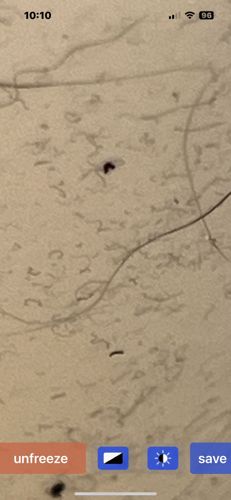Fungus Gnat or Drain Fly Larva
Scientific Name: Sciaridae species (for fungus gnats) or Psychodidae species (for drain flies). Specific species cannot be identified from the image.
Order & Family: Order: Diptera (flies). Family: Sciaridae (fungus gnats) or Psychodidae (drain flies), depending on specific identification not fully discernable from the image.
Size: Larvae typically range from 1 to 10 mm in length, depending on the specific fly species. Based on the scale suggested by what appears to be dust and fibers, these larvae are likely on the smaller end of this range, probably 2-5 mm.

Natural Habitat
Given the appearance of the larvae and surrounding material, it suggests a moist environment rich in decaying organic matter. This could include damp soil of houseplants (fungus gnats), drains, sewers, septic tanks, or other continuously moist areas with bio-film accumulation (drain flies).
Diet & Feeding
The image appears to show small, dark, worm-like creatures on a light surface, which are highly suggestive of fly larvae, possibly fungus gnat larvae or drain fly larvae. Adult flies feed on decaying organic matter, fungi, and sometimes plant sap. The larvae (maggots) primarily feed on decaying organic matter, fungi, algae, and microorganisms present in their moist environments.
Behavior Patterns
Flies are attracted to decaying organic matter. They lay their eggs in moist, decaying substances, and the larvae (maggots) feed on this material. Adult flies are active during the day and are often seen near food sources or breeding sites. They can reproduce rapidly under favorable conditions.
Risks & Benefits
Potential risks include being a nuisance pest, especially in homes or businesses. Drain flies can indicate plumbing issues or excessive moisture. Fungus gnats can cause some damage to plant roots, especially in nurseries, but generally are not harmful to healthy plants. They can be vectors for pathogens due to movement between unsanitary and clean areas. Benefits are minimal from a human perspective, but in nature, their larvae contribute to decomposition.
Identified on: 8/27/2025